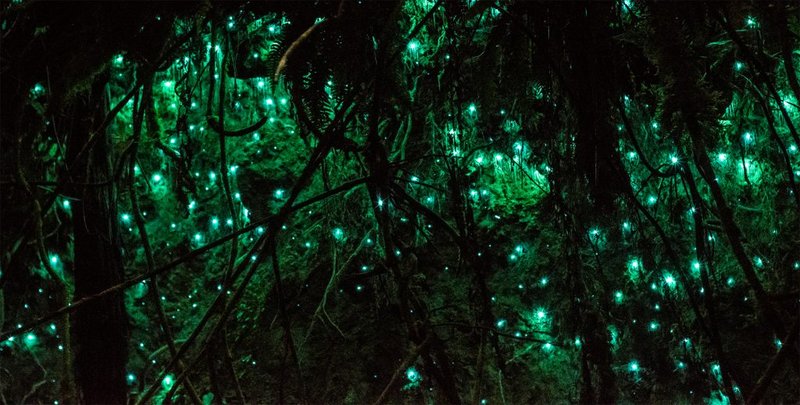
Glow worms, particularly the species *Arachnocampa luminosa*, are native to places like New Zealand and Australia. They’re not just about the light show. Their behavior at night offers a glimpse into how they hunt, communicate, and thrive in the dark. Grab a cup of coffee, and let’s dive into what makes these little bioluminescent creatures so fascinating!
Understanding Glow Worms and Their Habitat
Before we explore their nighttime antics, it’s helpful to get a sense of where glow worms call home. Typically found in damp, dark places like caves and dense forests, these creatures thrive in environments that provide shelter and humidity. They create silk threads that hang down from surfaces, which help them catch prey.
You might wonder why these specific locations? Glow worms love darkness, which aids in their hunting strategy. Their glow attracts flying insects, which become easy prey once they get tangled in the silk threads. Think of it as a nature-made trap, perfectly designed for snacking in the dark.
When observing glow worms, look for clusters of bright blue-green lights nestled among the foliage or cave walls. This is where they set up shop and prepare for a night of hunting.
The Science Behind Their Glow
The glow emitted by these worms is a result of a chemical reaction that occurs inside their bodies. This reaction involves the enzyme luciferase and a pigment called luciferin. When these chemicals mingle in the presence of oxygen, they produce light. It’s a bit like a tiny science experiment happening right under your nose!
What’s truly interesting is why they glow. The light serves two main purposes: attraction and camouflage. The glowing threads attract unsuspecting insects, while the glow itself helps to blend in with the moonlight filtering through the trees. It’s a clever way to keep their food close while staying hidden from predators.
So next time you see glow worms lighting up the night, remember—it’s not just a captivating display; it’s a carefully orchestrated strategy for survival.
Active Hunting at Night
One of the most captivating aspects of glow worm behavior is how they hunt. As night falls, their glow becomes brighter, signaling that it’s time for a feast. They rely on their silk threads to catch food, which primarily consists of small flying insects like moths.
When a hapless insect gets trapped, the glow worm senses the vibrations and can quickly reel in its catch. It’s quite the spectacle if you’re lucky enough to witness it! Imagine sitting quietly in the dark and suddenly seeing a worm tugging its catch, with its silk spinning in the air.
This active hunting phase usually peaks in the early hours of the night. If you’re out watching glow worms, pay attention to how they react to changes in light and sound. A sudden noise might cause them to dim their glow, making it harder for predators to spot them.
Communication Through Light
Glow worms don’t just shine randomly; they communicate through their glow in fascinating ways. The intensity and rhythm of their light can convey different messages, which is particularly important during mating season. Male glow worms often respond to the light patterns of females to attract them.
Here’s an interesting tidbit: the glow can also indicate a glow worm’s health. Brighter, more consistent lights can signify a well-fed, healthy worm, while dimmer lights may indicate stress or a lack of food. Imagine it as a signal reflecting their well-being—it’s nature’s way of showing who’s thriving in the dark.
If you’re keen on observing this communication, try to find a quiet spot and watch how different glow worms interact with each other. You might notice some are more vibrant than others, telling their own stories through light.
Environmental Challenges and Adaptations
Just like any creature, glow worms face environmental challenges. Changes in climate, habitat destruction, and pollution can impact their ability to thrive. For instance, if the humidity levels drop, their silk threads may not catch as many insects, impacting their food supply.
To cope with these challenges, glow worms have adapted in several ways. They can alter the brightness of their glow based on stress levels or environmental conditions. By dimming their lights, they conserve energy when food is scarce or conditions are tough.
If you’re observing glow worms in the wild, keep an eye on their surroundings. Polluted areas or places that lack vegetation may not host as many glow worms, revealing the delicate balance these creatures maintain with their environment.
The Best Time to Observe Glow Worm Behavior
If you’re planning a glow worm expedition, timing is everything. The best time to observe their vibrant displays is on calm, clear nights, ideally during the warmer months. This is when they’re most active and visible.
A great tip is to go out just after sunset, allowing your eyes to adjust to the darkness. Position yourself in a quiet area away from artificial light to truly appreciate the show. You might want to bring a flashlight with a red filter or cover it with a cloth to minimize disturbance.
As you settle in, be patient. Good things come to those who wait! Observe how the glow worms flicker and fade, and take a moment to soak in the magic of nature happening all around you.
Final Thoughts on Glow Worm Behavior
Glow worms are incredible creatures that light up the night with their unique behaviors. From their clever hunting strategies to their captivating communication, there’s so much to learn from them. When you find yourself in an area where they thrive, take the time to observe their natural rhythms and challenges.
Remember, these little wonders are not just about their glow but are a vital part of their ecosystem. The next time you see a glow worm shining brightly in the night, you’ll know it’s not just a pretty light show—it’s a story of survival and adaptation. So grab your flashlight, hit the trails, and enjoy this natural spectacle!

